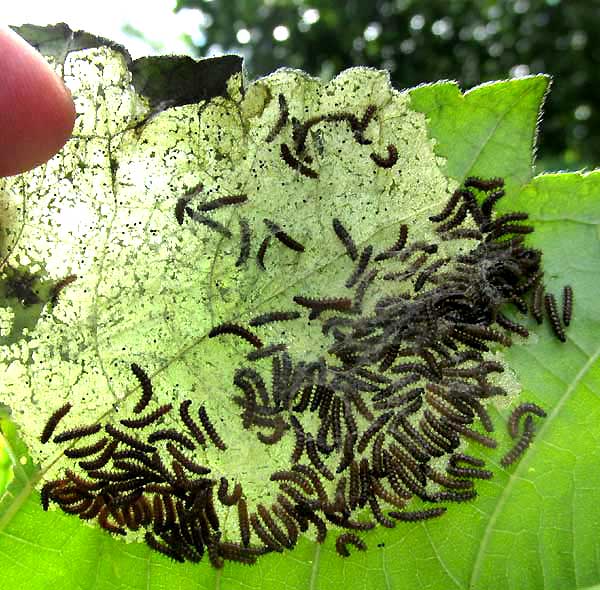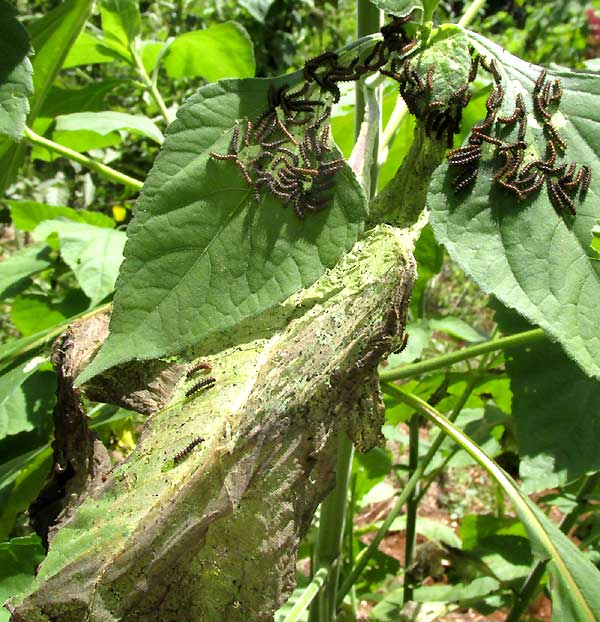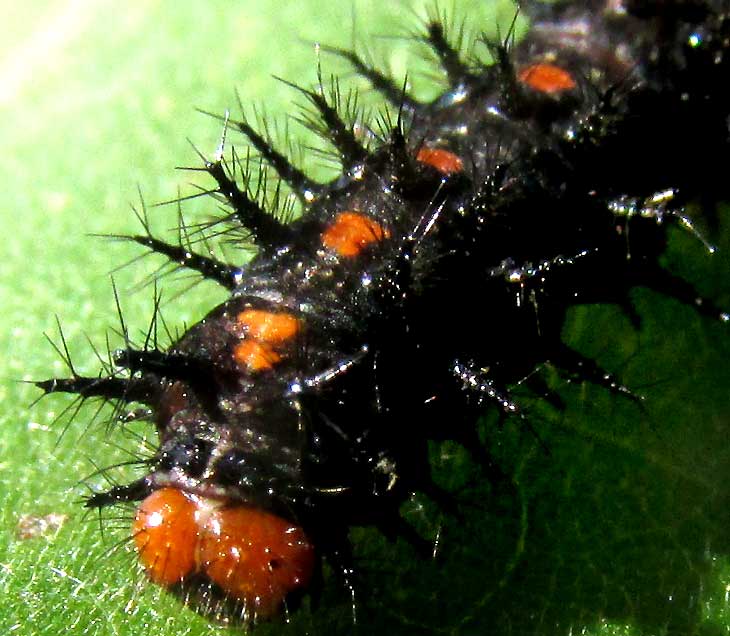Excerpts from Jim Conrad's
Naturalist Newsletter

from the July 28, 2013 Newsletter issued from the Frio Canyon Nature Education Center in the valley of the Dry Frio River in northern Uvalde County, southwestern Texas, on the southern border of the Edwards Plateau; elevation ~1750m (~5750 ft); N29.62°, W99.86°; USA
BORDERED or SUNFLOWER PATCH CATERPILLAR
Each morning I bike into the valley to water plants at the red cabin where I lived last winter. One job there is watering a row of ornamental sunflowers planted along a fence. This week a certain little black caterpillar species began eating the sunflowers' leaves, as shown above.
Volunteer identifier Bea in Ontario quickly pegged the caterpillar as that of the butterfly known as the Bordered Patch, Chlosyne lacinia. Bordered Patches are common here. Our "Butterflies of Uvalde County" picture of it resides at http://www.backyardnature.net/n/a/uvalde/005.jpg.
The "Butterflies and Moths of North America" webpage for this species describes the caterpillars as feeding on plants in the Composite or Sunflower Family, which among our wildflowers and weeds by far is the most represented of all plant families, so Bordered Patch butterflies should feel very much at home here, and are to be expected on sunflowers. In fact, another common name for the species is Sunflower Patch.
Bordered Patches are mostly a tropical and subtropical species, occurring from Argentina north through Mexico to southern California, casually to Colorado, Nebraska, and Kansas, and rarely even to western Missouri. Being found over such a large area, there's much variation in the caterpillar's appearance, from mostly orange with black spines, like ours, to black with a red-orange back stripe, to almost completely black. All variations have a red-orange head, though.
Neighbor Phred says that masses of little black caterpillars have been eating his sunflowers. I'm guessing that he has Bordered Patch caterpillars, for it's known that small, recently hatched Bordered Patch caterpillars are gregarious but when they grow larger they become solitary, like ours. I read that in southern Texas broods of Bordered Patch caterpillars may be produced throughout the year, and that during hot weather they may "aestivate," which is a state of reduced growth and development in response to heat and/or dryness, similar to winter hibernation.
issued on August 26, 2019 from near Tepakán, Yucatán, MÉXICO
BORDERED PATCH CATERPILLAR INSTARS
Last week I remarked that Bordered Patch butterflies were abundant around the rancho's stone hut. One reason probably is that tall sunflowers grow all around the hut, and Bordered Patch caterpillars feed on members of the Composite or Aster Family, especially sunflowers. This week the sunflowers' big leaves developed large blotches of dead and dying tissue. Below, you can see one such blotch, and the cause of it.:

With my fingertip for scale in the picture's upper, left corner, you can see that these are tiny, young -- "early instar" -- recently hatched caterpillars. And the caterpillars' gregarious urge is obvious. On some sunflowers, larger or "middle instar" caterpillars create larger dead spots, and the caterpillars are still gregarious, but not quite as obsessively, as shown below:

In that picture the whole bottom, left corner shows just part of a large leaf completely destroyed, with nothing remaining but the nonfunctional network of veins. On some plants, already a few much larger, late instar individuals are showing up, one shown below:

This individual was feeding alone. The earlier instars displayed less orange along the back, and had black heads, as opposed to this one's orange head.
Once I saw the above late instar, I realized that up in Texas we've already seen this species, though up there the caterpillars displayed much larger areas of orange.
One new piece of information I didn't have in Texas is that sunflowers contain toxins that are ingested by the caterpillars, and these toxins are passed on to the adult butterflies, which helps explain why so many Bordered Patch butterflies swarm around the hut these days.